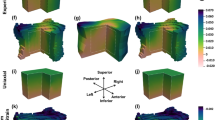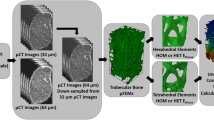Abstract
With improving clinical CT scanning technology, the accuracy of CT-based finite element (FE) models of the human skeleton may be ameliorated by an enhanced description of apparent level bone mechanical properties. Micro-finite element (μFE) modeling can be used to study the apparent elastic behavior of human cancellous bone. In this study, samples from the femur, radius and vertebral body were investigated to evaluate the predictive power of morphology–elasticity relationships and to compare them across different anatomical regions. μFE models of 701 trabecular bone cubes with a side length of 5.3 mm were analyzed using kinematic boundary conditions. Based on the FE results, four morphology–elasticity models using bone volume fraction as well as full, limited or no fabric information were calibrated for each anatomical region. The 5 parameter Zysset–Curnier model using full fabric information showed excellent predictive power with coefficients of determination (\({r_{\rm adj}^2}\)) of 0.98, 0.95 and 0.94 of the femur, radius and vertebra data, respectively, with mean total norm errors between 14 and 20%. A constant orthotropy model and a constant transverse isotropy model, where the elastic anisotropy is defined by the model parameters, yielded coefficients of determination between 0.90 and 0.98 with total norm errors between 16 and 25%. Neglecting fabric information and using an isotropic model led to \({r_{\rm adj}^2}\) between 0.73 and 0.92 with total norm errors between 38 and 49%. A comparison of the model regressions revealed minor but significant (p<0.01) differences for the fabric–elasticity model parameters calibrated for the different anatomical regions. The proposed models and identified parameters can be used in future studies to compute the apparent elastic properties of human cancellous bone for homogenized FE models.
Similar content being viewed by others
References
Arbenz P, van Lenthe G, Mennel U, Muller R, Sala M (2008) A scalable multi-level preconditioner for matrix-free μ-finite element analysis of human bone structures. Int J Numer Methods Eng 73(7): 927–947
Bougherara H, Zdero R, Mahboob Z, Dubov A, Shah S, Schemitsch EH (2010) The biomechanics of a validated finite element model of stress shielding in a novel hybrid total knee replacement. Proc Inst Mech Eng H 224(10): 1209–1219
Charlebois M, Pretterklieber M, Zysset PK (2010) The role of fabric in the large strain compressive behavior of human trabecular bone. J Biomech Eng 132(12): 121006.1–121006.10
Chevalier Y, Pahr D, Allmer H, Charlebois M, Zysset P (2007) Validation of a voxel-based fe method for prediction of the uniaxial apparent modulus of human trabecular bone using macroscopic mechanical tests and nanoindentation. J Biomech 40(15): 3333–3340
Chevalier Y, Quek E, Borah B, Gross G, Stewart J, Lang T, Zysset P (2010) Biomechanical effects of teriparatide in women with osteoporosis treated previously with alendronate and risedronate: results from quantitative computed tomography-based finite element analysis of the vertebral body. Bone 46(1): 41–48
Cowin SC (1985) The relationship between the elasticity tensor and the fabric tensor. Mech Mater 4(2): 137–147
Cristofolini L, Schileo E, Juszczyk M, Taddei F, Martelli S, Viceconti M (2010) Mechanical testing of bones: the positive synergy of finite element models and in vitro experiments. Philos Trans A Math Phys Eng Sci 368(1920): 2725–2763
Curnier A, He QC, Zysset P (1994) Conewise linear elastic materials. J Elast 37: 1–38
Gibson L (1985) The mechanical behaviour of cancellous bone. J Biomech 18(5): 317–328
Goulet R, Goldstein S, Ciarelli M, Kuhn J, Brown M, Feldkamp L (1994) The relationship between the structural and orthogonal compressive properties of trabecular bone. J Biomech 27(4): 375–389
Graeff C, Timm W, Nickelsen TN, Farrerons J, Marin F, Barker C, Gluer CC (2007) Monitoring teriparatide-associated changes in vertebral microstructure by high-resolution CT in vivo: results from the EUROFORS study. J Bone Miner Res 2007(22): 1426–1433 (J Bone Miner Res 22914261433)
Gross T, Pahr DH, Peyrin F, Zysset PK (2012) Mineral heterogeneity has a minor influence on the apparent elastic properties of human cancellous bone: a SRμCT-based finite element study. Comput Methods Biomech Biomed Eng http://dx.doi.org/10.1080/10255842.2011.581236
Harrigan TP, Jasty M, Mann RW, Harris WH (1988) Limitations of the continuum assumption in cancellous bone. J Biomech 21(4): 269–275
Hildebrand T, Laib A, Muller R, Dequeker J, Ruegsegger P (1999) Direct three-dimensional morphometric analysis of human cancellous bone: microstructural data from spine, femur, iliac crest, and calcaneus. J Bone Miner Res 14(7): 1167–1174
Hipp JA, Jansujwicz A, Simmons CA, Snyder BD (1996) Trabecular bone morphology from micro-magnetic resonance imaging. J Bone Miner Res 11(2): 286–292
Hollister S (1994) A homogenization sampling procedure for calculating trabecular bone effective stiffness and tissue level stress. J Biomech 27(4): 433–444
Jones AC, Wilcox RK (2008) Finite element analysis of the spine: towards a framework of verification, validation and sensitivity analysis. Med Eng Phys 30(10): 1287–1304
Kabel J, Van Rietbergen B, Odgaard A, Huiskes R (1999) Constitutive relationships of fabric, density, and elastic properties in cancellous bone architecture. Bone 25(4): 481–486
Keyak J, Sigurdsson S, Karlsdottir G, Oskarsdottir D, Sigmarsdottir A, Zhao S, Kornak J, Harris T, Sigurdsson G, Jonsson B, Siggeirsdottir K, Eiriksdottir G, Gudnason V, Lang T (2011) Male-female differences in the association between incident hip fracture and proximal femoral strength: a finite element analysis study. Bone 84(6): 1239–1245
Mulder L, van Rietbergen B, Noordhoek N, Ito K (2012) Determination of vertebral and femoral trabecular morphology and stiffness using a flat-panel C-arm-based CT approach. Bone 50(1): 200– 208
Odgaard A, Andersen K, Melsen F, Gundersen HJG (1990) A direct method for fast three-dimensional serial reconstruction. J Microsc 159(3): 335–342
Pahr D, Zysset P (2008) Influence of boundary conditions on computed apparent elastic properties of cancellous bone. Biomech Model Mechanobiol 7(6): 463–476
Pahr D, Zysset P (2009) A comparison of enhanced continuum FE with micro FE models of human vertebral bodies. J Biomech 42(4): 455–462
Pahr DH, Dall’ara E, Varga P, Zysset PK (2012) HR-pQCT-based homogenised finite element models provide quantitative predictions of experimental vertebral body stiffness and strength with the same accuracy as μ FE models. Comput Methods Biomech Biomed Eng 15(7): 711–720
Roychowdhury A (2009) Application of the finite element method in orthopedic implant design. J Long-Term Eff Med Implants 19(1): 55–82
Ruegsegger P, Koller B, Muller R (1996) A microtomographic system for the nondestructive evaluation of bone architecture. Calcif Tissue Int 58(1): 24–29
Silva MJ, Keaveny TM, Hayes WC (1998) Computed tomography-based finite element analysis predicts failure loads and fracture patterns for vertebral sections. J Orthop Res 16(3): 300–308
Taddei F, Cristofolini L, Martelli S, Gill H, Viceconti M (2006) Subject-specific finite element models of long bones: An in vitro evaluation of the overall accuracy. J Biomech 39(13): 2457–2467
Turner CH, Cowin SC, Rho JY, Ashman RB, Rice JC (1990) The fabric dependence of the orthotropic elastic constants of cancellous bone. J Biomech 23(6): 549–561
Varga P, Dall’Ara E, Pahr DH, Pretterklieber M, Zysset PK (2011) Validation of an hr-pqct-based homogenized finite element approach using mechanical testing of ultra-distal radius sections. Biomech Model Mechanobiol 10(4): 431–444
Varga P, Zysset PK (2009) Assessment of volume fraction and fabric in the distal radius using hr-pqct. Bone 45(5): 909–917
Whitehouse WJ (1974) The quantitative morphology of anisotropic trabecular bone. J Microsc 101(Pt2): 153–168
Wolfram U, Wilke HJ, Zysset P (2010) Valid μ finite element models of vertebral trabecular bone can be obtained using tissue properties measured with nanoindentation under wet conditions. J Biomech 43(9): 1731–1737
Zysset P (2003) A review of morphology–elasticity relationships in human trabecular bone: theories and experiments. J Biomech 36(10): 1469–1485
Zysset P, Edward Guo X, Edward Hoffler C, Moore K, Goldstein S (1999) Elastic modulus and hardness of cortical and trabecular bone lamellae measured by nanoindentation in the human femur. J Biomech 32(10): 1005–1012
Author information
Authors and Affiliations
Corresponding author
Rights and permissions
About this article
Cite this article
Gross, T., Pahr, D.H. & Zysset, P.K. Morphology–elasticity relationships using decreasing fabric information of human trabecular bone from three major anatomical locations. Biomech Model Mechanobiol 12, 793–800 (2013). https://doi.org/10.1007/s10237-012-0443-2
Received:
Accepted:
Published:
Issue Date:
DOI: https://doi.org/10.1007/s10237-012-0443-2




